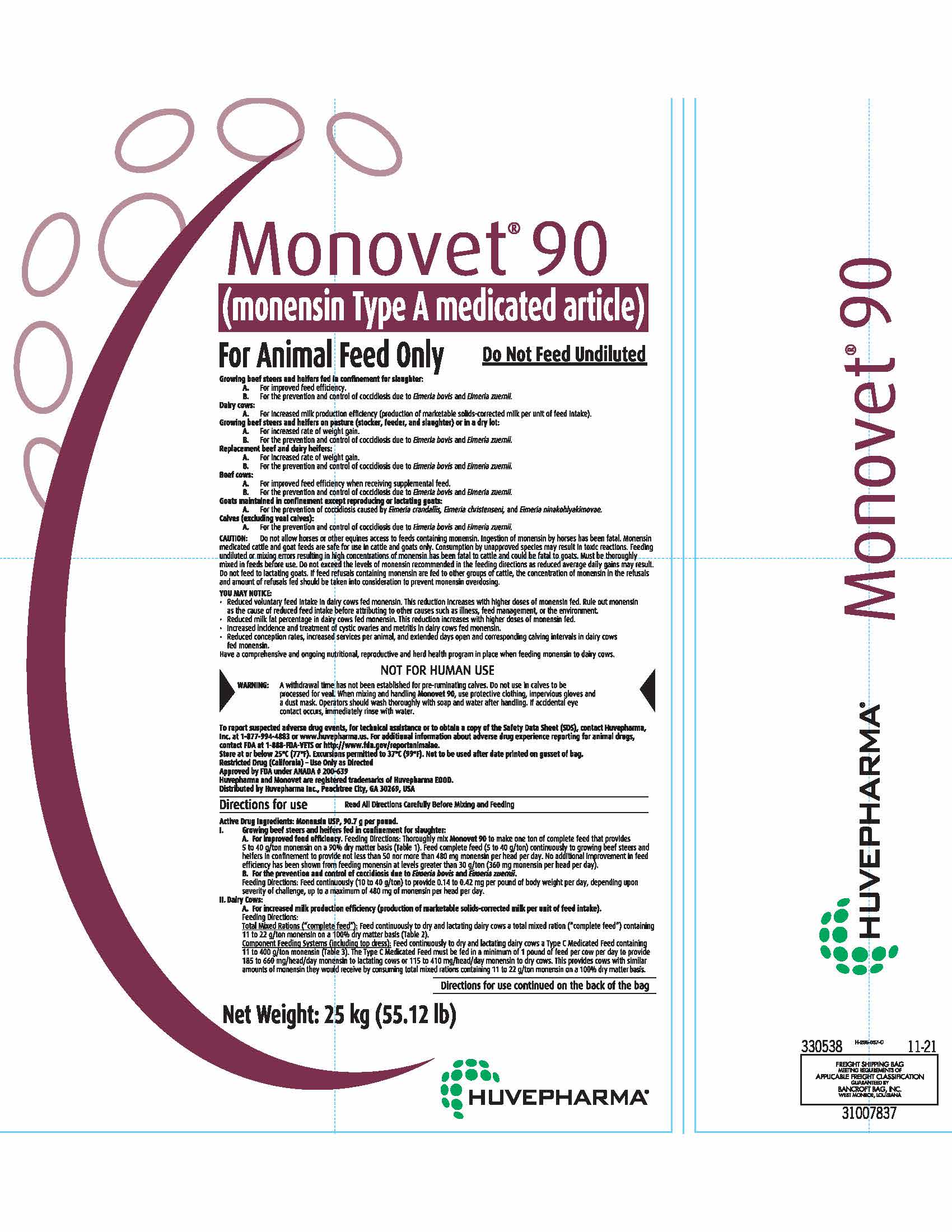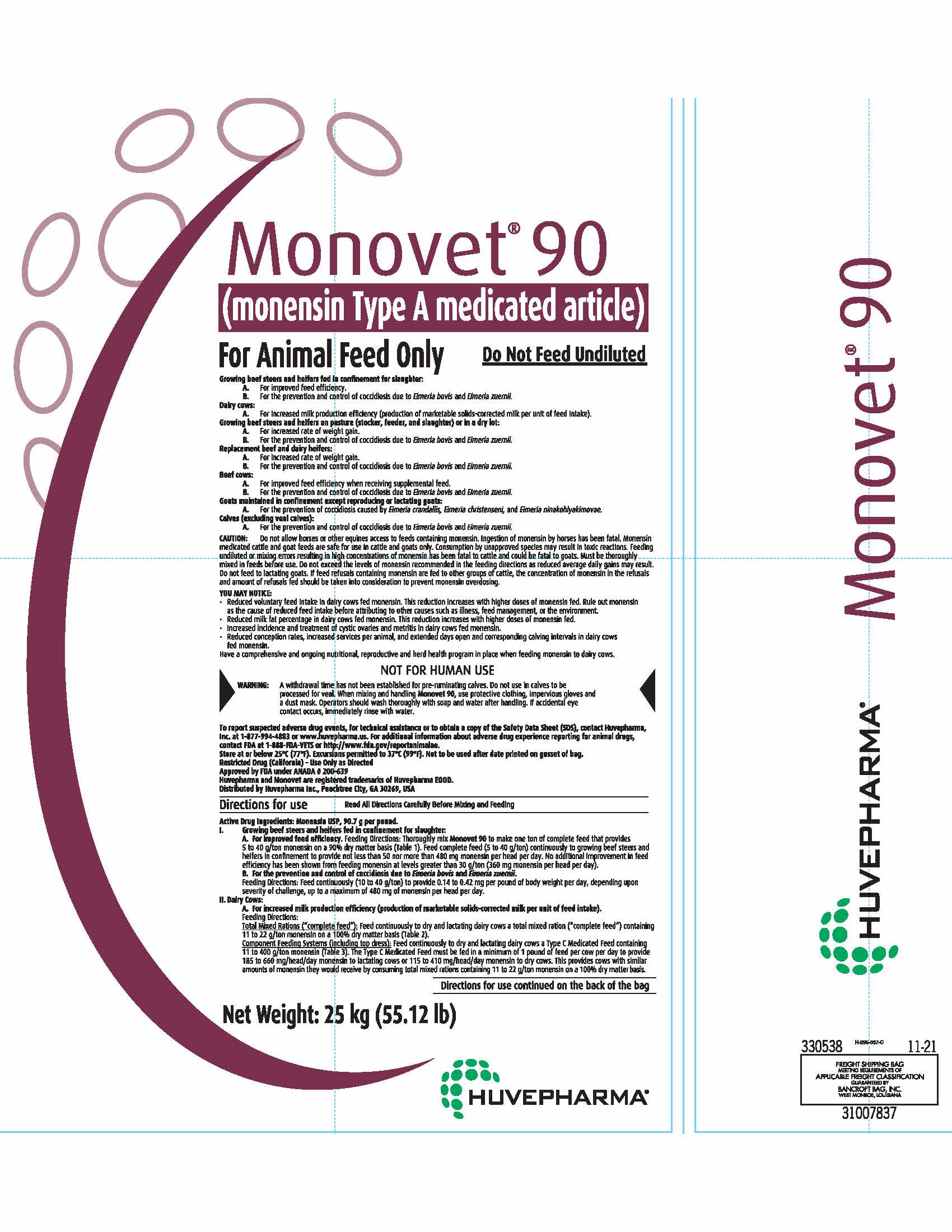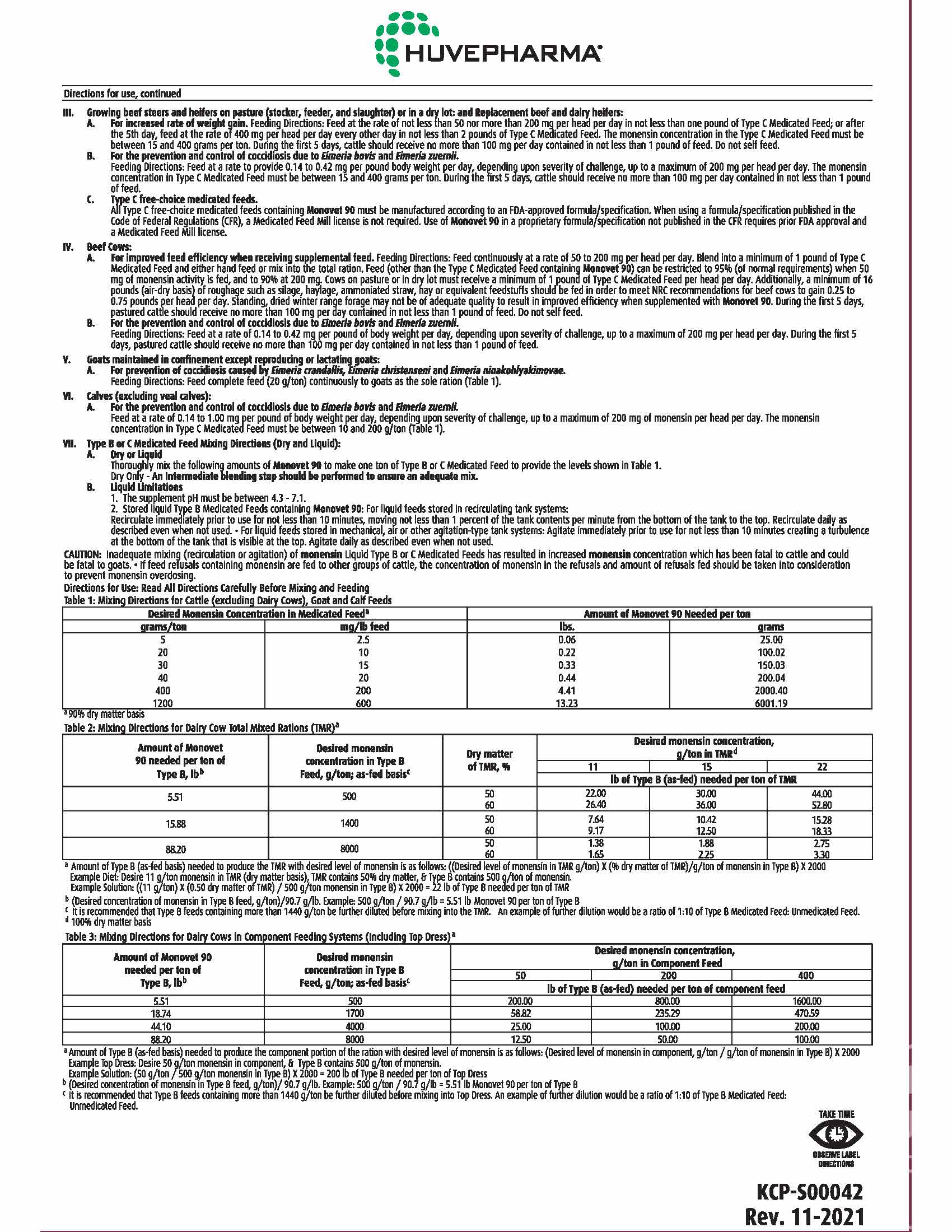Label: MONOVET 90- monensin granule
- NDC Code(s): 23243-0064-5
- Packager: Huvepharma, Inc.
- Category: OTC TYPE A MEDICATED ARTICLE ANIMAL DRUG LABEL
- DEA Schedule: None
- Marketing Status: Abbreviated New Animal Drug Application
Drug Label Information
Updated March 1, 2022
If you are a consumer or patient please visit this version.
- Download DRUG LABEL INFO: PDF XML
- Official Label (Printer Friendly)
- SPL UNCLASSIFIED SECTION
-
INDICATIONS & USAGE
Growing beef steers and heifers fed in confinement for slaughter:
A. For improved feed efficiency.
B. For the prevention and control of coccidiosis due to Eimeria bovis and Eimeria zuernii.
Dairy cows:
A. For increased milk production efficiency (production of marketable solids-corrected milk per unit of feed intake).
Growing beef steers and heifers on pasture (stocker, feeder, and slaughter) or in a dry lot:
A. For increased rate of weight gain.
B. For the prevention and control of coccidiosis due to Eimeria bovis and Eimeria zuernii.
Replacement beef and dairy heifers:
A. For increased rate of weight gain.
B. For the prevention and control of coccidiosis due to Eimeria bovis and Eimeria zuernii.
Beef cows:
A. For improved feed efficiency when receiving supplemental feed.
B. For the prevention and control of coccidiosis due to Eimeria bovis and Eimeria zuernii.
Goats maintained in confinement except reproducing or lactating goats:
A. For the prevention of coccidiosis caused by Eimeria crandallis, Eimeria christenseni, and Eimeria ninakohlyakimovae.
Calves (excluding veal calves):
A. For the prevention and control of coccidiosis due to Eimeria bovis and Eimeria zuernii. -
GENERAL PRECAUTIONS
CAUTION: Do not allow horses or other equines access to feeds containing monensin.
Ingestion of monensin by horses has been fatal. Monensin medicated cattle and goat
feeds are safe for use in cattle and goats only. Consumption by unapproved species
may result in toxic reactions. Feeding undiluted or mixing errors resulting in high
concentrations of monensin has been fatal to cattle and could be fatal to goats.
Must be thoroughly mixed in feeds before use. Do not exceed the levels of monensin
recommended in the feeding directions as reduced average daily gains may result.
Do not feed to lactating goats. If feed refusals containing monensin are fed to other
groups of cattle, the concentration of monensin in the refusals and amount of refusals
fed should be taken into consideration to prevent monensin overdosing.YOU MAY NOTICE:
• Reduced voluntary feed intake in dairy cows fed monensin. This reduction increases
with higher doses of monensin fed. Rule out monensin as the cause of reduced feed
intake before attributing to other causes such as illness, feed management, or the
environment.
• Reduced milk fat percentage in dairy cows fed monensin. This reduction increases
with higher doses of monensin fed.
• Increased incidence and treatment of cystic ovaries and metritis in dairy cows fed
monensin.
• Reduced conception rates, increased services per animal, and extended days open and
corresponding calving intervals in dairy cows fed monensin.Have a comprehensive and ongoing nutritional, reproductive and herd health program in
place when feeding monensin to dairy cows. -
WARNINGS
NOT FOR HUMAN USE
WARNING: A withdrawal time has not been established for pre-ruminating calves. Do not use in calves to be
processed for veal. When mixing and handling Monovet 90, use protective clothing, impervious
gloves and a dust mask. Operators should wash thoroughly with soap and water after handling. If
accidential eye contact occurs, immediately rinse with water.To report suspected adverse drug events, for technical assistance or to obtain a
copy of the Safety Data Sheet (SDS), contact Huvepharma, Inc. at 1-877-994-4883
or www.huvepharma.us. For additional information about adverse drug experience
reporting for animal drugs, contact FDA at 1-888-FDA-VETS or
http://www.fda.gov/reportanimalae.
Store at or below 25°C (77°F). Excursions permitted to 37°C (99°F). Not to be used after date printed on gusset of bag.
Restricted Drug (California) - Use Only as Directed
Approved by FDA under ANADA # 200-639
Huvepharma and Monovet are registered trademarks of Huvepharma EOOD.
Distributed by Huvepharma Inc., Peachtree City, GA 30269, USA -
Directions for Use Read All Directions Carefully Before Mixing and Feeding
Active Drug Ingredients: Monensin USP, 90.7 g per pound.
I. Growing beef steers and heifers fed in confinement for slaughter:
A. For improved feed efficiency. Feeding Directions: Thoroughly mix Monovet 90 to make one
ton of complete feed that provides 5 to 40 g/ton monensin on a 90% dry matter basis (Table 1).
Feed complete feed (5 to 40 g/ton) continuously to growing beef steers and heifers in
confinement to provide not less than 50 nor more than 480 mg monensin per head per day. No
additional improvement in feed efficiency has been shown from feeding monensin at levels greater
than 30 g/ton (360 mg monensin per head per day).
B. For the prevention and control of coccidiosis due to Eimeria bovis and Eimeria zuernii.
Feeding Directions: Feed continuously (10 to 40 g/ton) to provide 0.14 to 0.42 mg per pound of
body weight per day, depending upon severity of challenge, up to a maximum of 480 mg of
monensin per head per day.
II. Dairy Cows:
A. For increased milk production efficiency (production of marketable solids-corrected milk
per unit of feed intake).
Feeding Directions:
Total Mixed Rations (“complete feed”): Feed continuously to dry and lactating dairy cows a total mixed ration
(“complete feed”) containing 11 to 22 g/ton monensin on a 100% dry matter basis (Table 2).
Component Feeding Systems (including top dress): Feed continuously to dry and lactating dairy cows a Type C
Medicated Feed containing 11 to 400 g/ton monensin (Table 3). The Type C Medicated Feed must be
fed in a minimum of 1 pound of feed per cow per day to provide 185 to 660 mg/head/day monensin
to lactating cows or 115 to 410 mg/head/day monensin to dry cows. This provides cows with similar
amounts of monensin they would receive by consuming total mixed rations containing 11 to 22 g/ton
monensin on a 100% dry matter basis.Directions for use continued on the back of the bag
Net Weight: 25 kg (55.12 lb)
-
Directions for use, continued
III. Growing beef steers and heifers on pasture (stocker, feeder, and slaughter) or in a dry lot: and
Replacement beef and dairy heifers:
A. For increased rate of weight gain. Feeding Directions: Feed at the rate of not less than 50 nor more
than 200 mg per head per day in not less than one pound of Type C Medicated Feed; or after the 5th
day, feed at the rate of 400 mg per head per day every other day in not less than 2 pounds of Type C
Medicated Feed. The monensin concentration in the Type C Medicated Feed must be between 15 and 400
grams per ton. During the first 5 days, cattle should receive no more than 100 mg per day contained
in not less than 1 pound of feed. Do not self feed.
B. For the prevention and control of coccidiosis due to Eimeria bovis and Eimeria zuernii.
Feeding Directions: Feed at a rate to provide 0.14 to 0.42 mg per pound body weight per day,
depending upon severity of challenge, up to a maximum of 200 mg per head per day. The monensin
concentration in Type C Medicated Feed must be between 15 and 400 grams per ton. During the first
5 days, cattle should receive no more than 100 mg per day contained in not less than 1 pound of feed.
C. Free-Choice (Self-Fed) Medicated Feeds.
All Type C free-choiee medicated leeds containing Monovet 90 must be manufactured according
to an FDA-approved formula/specification published in the Code of Federal Regulation (CFR),
a Medicated Feed Mill license is not required. Use of Monovet 90 in a proprietary
formula/specification not published in the CFR requires prior FDA approval and a Medicated
Feed Mill license.IV. Beef Cows:
A. For improved feed efficiency when receiving supplemental feed.
Feeding Directions: Feed continuously at a rate of 50 to 200 mg per head per day. Blend into a minimum
of 1 pound of Type C Medicated Feed and either hand feed or mix into the total ration. Feed (other than
the Type C Medicated Feed containing Monovet 90) can be restricted to 95% (of normal requirements)
when 50 mg of monensin activity is fed, and to 90% at 200 mg. Cows on pasture or in dry lot must receive
a minimum of 1 pound of Type C Medicated Feed per head per day. Additionally, a minimum of 16 pounds
(air-dry basis) of roughage such as silage, haylage, ammoniated straw, hay or equivalent feedstuffs should
be fed in order to meet NRC recommendations for beef cows to gain 0.25 to 0.75 pounds per head per day.
Standing, dried winter range forage may not be of adequate quality to result in improved efficiency when
supplemented with Monovet 90. During the first 5 days, pastured cattle should receive no more than 100
mg per day contained in not less than 1 pound of feed. Do not self feed.
B. For the prevention and control of coccidiosis due to Eimeria bovis and Eimeria zuernii.
Feeding Directions: Feed at a rate of 0.14 to 0.42 mg per pound of body weight per day, depending
upon severity of challenge, up to a maximum of 200 mg per head per day. During the first 5 days,
pastured cattle should receive no more than 100 mg per day contained in not less than 1 pound of feed.V. Goats maintained in confinement except reproducing or lactating goats:
A.For prevention of coccidiosis caused by Eimeria crandallis, Eimeria christenseni and Eimeria
ninakohlyakimovae.
Feeding Directions: Feed complete feed (20 g/ton) continuously to goats as the sole ration (Table 1).
VI. Calves (excluding veal calves):
A. For the prevention and control of coccidiosis due to Eimeria bovis and Eimeria zuernii.
Feed at a rate of 0.14 to 1.00 mg per pound of body weight per day, depending upon severity of challenge,
up to a maximum of 200 mg of monensin per head per day. The monensin concentration in Type C Medicated
Feed must be between 10 and 200 g/ton (Table 1).VII. Type B or C Medicated Feed Mixing Directions (Dry and Liquid):
A. Dry or Liquid
Thoroughly mix the following amounts of Monovet 90 to make one ton of Type B or C Medicated Feed to
provide the levels shown in Table 1.
Dry Only - An Intermediate blending step should be performed to ensure an adequate mix.
B. Liquid Limitations
1. The supplement pH must be between 4.3 - 7.1.
2. Stored liquid Type B Medicated Feeds containing Monovet 90: For liquid feeds stored in recirculating
tank systems: Recirculate immediately prior to use for not less than 10 minutes, moving not less than
1 percent of the tank contents per minute from the bottom of the tank to the top. Recirculate daily as
described even when not used. • For liquid feeds stored in mechanical, air or other agitation-type tank
systems: Agitate immediately prior to use for not less than 10 minutes creating a turbulence at the
bottom of the tank that is visible at the top. Agitate daily as described even when not used. -
GENERAL PRECAUTIONS
CAUTION: Inadequate mixing (recirculation or agitation) of monensin Liquid Type B or C Medicated Feeds has resulted
in increased monensin concentration which has been fatal to cattle and could be fatal to goats. • If feed refusals
containing monensin are fed to other groups of cattle, the concentration of monensin in the refusals and amount of
refusals fed should be taken into consideration to prevent monensin overdosing. -
Directions for Use: Read All Directions Carefully Before Mixing and Feeding
Table 1: Mixing Directions for Cattle (excluding Dairy Cows), Goat and Calf Feeds Desired Monensin Concentration in Medicated Feeda Amount of Monovet 90 Needed per ton grams/ton mg/lb feed lbs. grams 5 2.5 0.06 25.00 20 10 0.22 100.02 30 15 0.33 150.03 40 20 0.44 200.04 400 200 4.41 2000.40 1200 600 13.23 6001.19 a 90% dry matter basis Table 2: Mixing Directions for Dairy Cow Total Mixed Rations (TMR)a Amount of Monovet
90 needed per ton of
Type B, lbbDesired monensin
concentration in Type B
Feed, g/ton; as-fed basiscDry Matter of TMR, % Desired monensin concentration, g/ton in TMRd
11 15 22 lb of Type B (as-fed) needed per ton of TMR 5.51 500 50
60
22.00
26.40
30.00
36.00
44.00
52.80
15.88 1400 50
60
7.64
9.17
10.42
12.50
15.28
18.33
88.20 8000 50
60
1.38
1.65
1.88
2.25
2.75
3.30
a Amount of Type B (as-fed basis) needed to produce the TMR with desired level of monensin is as follows: ((Desired level of monensin in TMR g/ton) X (% dry matter of TMR)/g/ton of monensin in Type B) X 2000
Example Diet: Desire 11 g/ton monensin in TMR (dry matter basis), TMR contains 50% dry matter, & Type B contains 500 g/ton of monensin.
Example Solution: ((11 g/ton) X (0.50 dry matter of TMR) / 500 g/ton monensin in Type B) X 2000 = 22 lb of Type B needed per ton of TMR
b (Desired concentration of monensin in Type B feed, g/ton)/90.7 g/lb. Example: 500 g/ton / 90.7 g/lb = 5.51 lb Monovet 90 per ton of Type B
c It is recommended that Type B feeds containing more than 1440 g/ton be further diluted before mixing into the TMR. An example of further dilution would be a ratio of 1:10 of Type B Medicated Feed: Unmedicated Feed.
d 100% dry matter basisTable 3: Mixing Directions for Dairy Cows in Component Feeding Systems (Including Top Dress) a Amount of Monovet 90
needed per ton of
Type B, lb b
Desired monensin
concentration in Type B
Feed, g/ton; as-fed basisc
Desired monensin concentration,
g/ton in Component Feed
50 200 400 lb of Type B (as-fed) needed per ton of component feed 5.51 500 200.00 800.00 1600.00 18.74 1700 58.82 235.29 470.59 44.10 4000 25.00 100.00 200.00 88.20 8000 12.50 50.00 100.00 a Amount of Type B (as-fed basis) needed to produce the component portion of the ration with desired level of monensin is as follows: (Desired level of monensin in component, g/ton / g/ton of monensin in Type B) X 2000
Example Top Dress: Desire 50 g/ton monensin in component, & Type B contains 500 g/ton of monensin.
Example Solution: (50 g/ton / 500 g/ton monensin in Type B) X 2000 = 200 lb of Type B needed per ton of Top Dress
b (Desired concentration of monensin in Type B feed, g/ton)/ 90.7 g/lb. Example: 500 g/ton / 90.7 g/lb = 5.51 lb Monovet 90 per ton of Type B
c It is recommended that Type B feeds containing more than 1440 g/ton be further diluted before mixing into Top Dress. An example of further dilution would be a ratio of 1:10 of Type B Medicated Feed:
Unmedicated Feed. - Take Time
- Bag Front
- Bag Back
-
INGREDIENTS AND APPEARANCE
MONOVET 90
monensin granuleProduct Information Product Type OTC TYPE A MEDICATED ARTICLE ANIMAL DRUG Item Code (Source) NDC:23243-0064 Route of Administration ORAL Active Ingredient/Active Moiety Ingredient Name Basis of Strength Strength MONENSIN (UNII: 906O0YJ6ZP) (MONENSIN - UNII:906O0YJ6ZP) MONENSIN 200 g in 1 kg Packaging # Item Code Package Description Marketing Start Date Marketing End Date 1 NDC:23243-0064-5 25 kg in 1 BAG Marketing Information Marketing Category Application Number or Monograph Citation Marketing Start Date Marketing End Date ANADA ANADA200639 07/01/2019 Labeler - Huvepharma, Inc. (619153559) Establishment Name Address ID/FEI Business Operations Huvepharma, Inc 883128204 medicated animal feed manufacture, analysis, manufacture, pack, label





